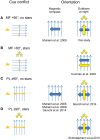A New View on an Old Debate: Type of Cue-Conflict Manipulation and Availability of Stars Can Explain the Discrepancies between Cue-Calibration Experiments with Migratory Songbirds
- PMID: 26941631
- PMCID: PMC4763052
- DOI: 10.3389/fnbeh.2016.00029
A New View on an Old Debate: Type of Cue-Conflict Manipulation and Availability of Stars Can Explain the Discrepancies between Cue-Calibration Experiments with Migratory Songbirds
Abstract
Migratory birds use multiple compass systems for orientation, including a magnetic, star and sun/polarized light compass. To keep these compasses in register, birds have to regularly update them with respect to a common reference. However, cue-conflict studies have revealed contradictory results on the compass hierarchy, favoring either celestial or magnetic compass cues as the primary calibration reference. Both the geomagnetic field and polarized light cues present at sunrise and sunset have been shown to play a role in compass cue integration, and evidence suggests that polarized light cues at sunrise and sunset may provide the primary calibration reference for the other compass systems. We tested whether migratory garden warblers recalibrated their compasses when they were exposed to the natural celestial cues at sunset in a shifted magnetic field, which are conditions that have been shown to be necessary for the use of a compass reference based on polarized light cues. We released the birds on the same evening under a starry sky and followed them by radio tracking. We found no evidence of compass recalibration, even though the birds had a full view of polarized light cues near the horizon at sunset during the cue-conflict exposure. Based on a meta-analysis of the available literature, we propose an extended unifying theory on compass cue hierarchy used by migratory birds to calibrate the different compasses. According to this scheme, birds recalibrate their magnetic compass by sunrise/sunset polarized light cues, provided they have access to the vertically aligned band of maximum polarization near the horizon and a view of landmarks. Once the stars appear in the sky, the birds then recalibrate the star compass with respect of the recalibrated magnetic compass. If sunrise and sunset information can be viewed from the same location, the birds average the information to get a true geographic reference. If polarized light information is not available near the horizon at sunrise or sunset, the birds temporarily transfer the previously calibrated magnetic compass information to the available celestial compasses. We conclude that the type of cue-conflict manipulation and the availability of stars can explain the discrepancies between studies.
Keywords: bird orientation; calibration; compass; magnetic field; migration; polarized light; stars; sun.
Figures




Similar articles
-
Calibration of magnetic and celestial compass cues in migratory birds--a review of cue-conflict experiments.J Exp Biol. 2006 Jan;209(Pt 1):2-17. doi: 10.1242/jeb.01960. J Exp Biol. 2006. PMID: 16354773 Review.
-
White-throated sparrows calibrate their magnetic compass by polarized light cues during both autumn and spring migration.J Exp Biol. 2009 Nov;212(Pt 21):3466-72. doi: 10.1242/jeb.032771. J Exp Biol. 2009. PMID: 19837888
-
Access to the sky near the horizon and stars does not play a crucial role in compass calibration of European songbird migrants.J Exp Biol. 2022 Aug 15;225(16):jeb243631. doi: 10.1242/jeb.243631. Epub 2022 Aug 23. J Exp Biol. 2022. PMID: 35903997
-
Polarized light cues underlie compass calibration in migratory songbirds.Science. 2006 Aug 11;313(5788):837-9. doi: 10.1126/science.1129709. Science. 2006. PMID: 16902138
-
Behavioural and physiological mechanisms of polarized light sensitivity in birds.Philos Trans R Soc Lond B Biol Sci. 2011 Mar 12;366(1565):763-71. doi: 10.1098/rstb.2010.0196. Philos Trans R Soc Lond B Biol Sci. 2011. PMID: 21282180 Free PMC article. Review.
Cited by
-
Geomagnetic disturbance associated with increased vagrancy in migratory landbirds.Sci Rep. 2023 Jan 9;13(1):414. doi: 10.1038/s41598-022-26586-0. Sci Rep. 2023. PMID: 36624156 Free PMC article.
-
Bogong moths use a stellar compass for long-distance navigation at night.Nature. 2025 Jul;643(8073):994-1000. doi: 10.1038/s41586-025-09135-3. Epub 2025 Jun 18. Nature. 2025. PMID: 40533549 Free PMC article.
-
Simulation experiment to test strategies of geomagnetic navigation during long-distance bird migration.Mov Ecol. 2021 Sep 15;9(1):46. doi: 10.1186/s40462-021-00283-5. Mov Ecol. 2021. PMID: 34526152 Free PMC article.
-
Gauge-and-compass migration: inherited magnetic headings and signposts can adapt to changing geomagnetic landscapes.Mov Ecol. 2023 Jul 5;11(1):37. doi: 10.1186/s40462-023-00406-0. Mov Ecol. 2023. PMID: 37408064 Free PMC article.
-
Feasibility of sun and magnetic compass mechanisms in avian long-distance migration.Mov Ecol. 2018 Jun 6;6:8. doi: 10.1186/s40462-018-0126-4. eCollection 2018. Mov Ecol. 2018. PMID: 29992024 Free PMC article. Review.
References
-
- Able K. P. (1982). Skylight polarization patterns at dusk influence migratory orientation in birds. Nature 299, 550–551. 10.1038/299550a0 - DOI
-
- Able K. P., Able M. A. (1990). Ontogeny of migratory orientation in the Savannah sparrow, Passerculus sandwichensis: calibration of the magnetic compass. Anim. Behav. 39, 905–913. 10.1016/S0003-3472(05)80955-8 - DOI
-
- Able K. P., Able M. A. (1993). Daytime calibration of magnetic orientation in a migratory bird requires a view of skylight polarization. Nature 364, 523–525. 10.1038/364523a0 - DOI
-
- Able K. P., Able M. A. (1995). Manipulations of polarized skylight calibrate magnetic orientation in a migratory bird. J. Comp. Physiol. A 177, 351–356. 10.1007/BF00192423 - DOI
LinkOut - more resources
Full Text Sources
Other Literature Sources

